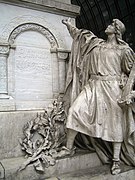Richard Wagner Monument (Berlin)
The Richard Wagner Memorial in the Großer Tiergarten in Berlin-Tiergarten is a monumental seated memorial for the composer Richard Wagner created by the sculptor Gustav Eberlein from 1901 to 1903 . It is located across from the Indian Embassy on Tiergartenstrasse .
The founder of the monument near Luiseninsel was the cosmetics manufacturer Ludwig Leichner . The former singer got rich from the innovative products of his powder and make-up factory . For the first lead-free stage make-up , he received awards at the Berlin Trade Fair in 1879 and at the Paris World Exhibition .
Gustav Eberlein, next to Reinhold Begas one of the most important representatives of Wilhelminian statecraft and one of the sculptors for the figures of the Siegesallee , won the competition for the monument in 1901, in which the sculptor Hermann Hidding also took part. The Richard Wagner Memorial is Eberlein’s last public monument in Germany.
Description of the monument
The compact neo-Romanesque plinth with the inscription Richard Wagner rises on the broad substructure . Richard Wagner's 2.7 meter high figure is enthroned on an armchair, probably looking into the unknown at the moment of inspiration. The left hand rests - perhaps feeling for notes - on the arm of the chair, while the right, clenched in a fist, weighs down a bundle of sheet music. Figures from his works surround the pedestal of the composer, who has become a spiritual hero in the spirit of the times . At the front of the pedestal, Wolfram von Eschenbach from the opera Tannhäuser and the singer's war on Wartburg with the lyre in his left hand - as an incursion of Kaiser Wilhelm II, in a way representative of the German nation - pays homage to Richard Wagner's genius. The laurel wreath and oak branch on his right foot are a sign of eternal fame. The oak branch can also be seen as a reference to the "German national tree" oak and thus as a national symbol.
On the east side, Tannhäuser from the opera of the same name has sunk down in pilgrim garb, and on the opposite west side, Kriemhild complains of Siegfried lying dead in front of her , both characters from Wagner's opera tetralogy The Ring of the Nibelung . This opera cycle also includes Alberich on the back of the monument , who spans the Nibelungenhort with his arms , and one of the Rhine daughters who teasingly reaches into Alberich's beard . Gustav Eberlein used Pentelic marble for the monument as well as for the substructure .
history
The unveiling of the monument on October 1, 1903, a social event in the presence of the imperial Prince Eitel Friedrich von Prussia , was recorded by Ludwig Leichner in an oil painting completed in 1908 by the history painter Anton von Werner . In the center of the picture, the prince in parade uniform greets Ludwig Leichner, who is accompanied on the right by Gustav Eberlein. Behind it is a group of Berlin artists, including the sculptor Peter Breuer , the architect Hermann Ende and the painter Ludwig Knaus . On the lower left edge of the picture, the painter painted himself into the action. His left-facing profile can be clearly seen in the middle of a group. The painter Adolph Menzel gave one of the speeches.
The memorial survived the Second World War without major damage. At the beginning of the 1980s, however, weather conditions and vandalism required measures to save the monument. The desolate condition of the marble and the enormous size of the monument made it impossible to keep the original monument and replace it with a replica. On the one hand, there was the risk that the stone would simply have crumbled during the implementation, on the other hand , there was no space available in the lapidary , the usual place of storage. In 1987, based on a design by the architect Marianne Wagner , the monument was given a protective roof, a steel structure in the form of a plexiglass-covered barrel vault . A wax coating also protects the stone from the weather.
Web links
- Entry in the Berlin State Monument List with further information
- Festive program of the unveiling and inauguration of the monument to Richard Wagner in Berlin , in: Digital collections of the State Institute for Music Research Prussian Cultural Heritage .
Coordinates: 52 ° 30 ′ 36 ″ N , 13 ° 21 ′ 44 ″ E







